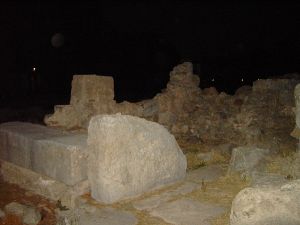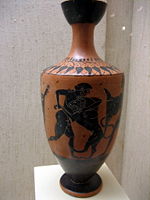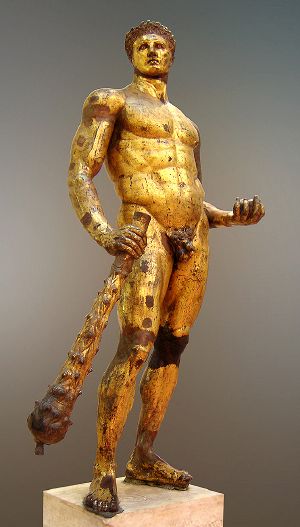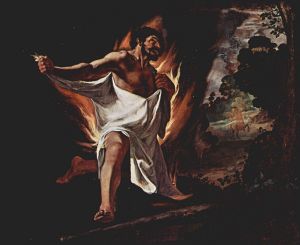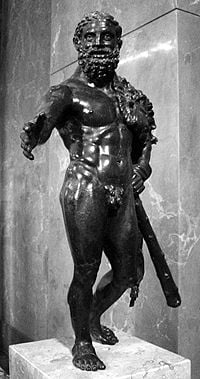
In Greek mythology, Heracles or Herakles (Roman: Hercules) meaning "glory of Hera," was a divine hero, the son of Zeus and Alcmene, foster son of Amphitryon and great-grandson (and half-brother) of Perseus. He was the greatest of the Greek heroes, a paragon of masculinity, the ancestor of royal clans who claimed to be Heracleidae and a champion of the Olympian order against chthonic monsters. In Rome and the modern West, he is known as Hercules, with whom the later Roman Emperors, in particular Commodus (r.180 to 192) and Maximian (r. 285 - 305), often identified themselves. The Romans adopted the Greek version of his life and works essentially unchanged, but added anecdotal detail of their own.
Extraordinary strength, courage, ingenuity, and sexual prowess were among his characteristic attributes. Although he was not as clever as the likes of Odysseus or Nestor in the Greek myths, Heracles used his wits on several occasions when his strength did not suffice, such as when laboring for the king Augeas of Elis, wrestling the giant Antaeus, or tricking Atlas into taking the sky back onto his shoulders. Together with Hermes he was the patron and protector of gymnasia and palaestrae. His iconographic attributes are the lion skin and the club. These qualities did not prevent him from being regarded as a playful figure who used games to relax from his labors, and who played a great deal with children. By conquering dangerous archaic forces he is said to have "made the world safe for mankind" and to be its benefactor. Heracles was an extremely passionate and emotional individual, capable of doing both great deeds for his friends (such as wrestling with Thanatos on behalf of Prince Admetus, who had regaled Heracles with his hospitality, or restoring his friend Tyndareus to the throne of Sparta after he was overthrown) and being a terrible enemy who would wreak horrible vengeance on those who crossed him, as Augeas, Neleus and Laomedon all found out to their cost.
Heroic character
Heracles was the greatest of Hellenic chthonic heroes, but unlike other Greek heroes, no tomb was identified as his. Heracles was both hero and god, as Pindar says heroes theos; at the same festival sacrifice was made to him, first as a hero, with a chthonic libation, and then as a god, upon an altar: thus he embodies the closest Greek approach to a "demi-god".[1] The core of the story of Heracles has been identified by Walter Burkert as originating in Neolithic hunter culture and traditions of shamanistic crossings into the netherworld.[2]
Heracles' role as a culture hero, whose death could be a subject of mythic telling, was accepted into the Olympian Pantheon during Classical times. This created an awkwardness in the encounter with Odysseus in the episode of Odyssey XI, called the Nekuia, where Odysseus encounters Heracles in Hades:
- And next I caught a glimpse of powerful Heracles—
- His ghost I mean: the man himself delights
- in the grand feasts of the deathless gods on high...
- Around him cries of the dead rang out like cries of birds
- scattering left and right in horror as on he came like night…"[3]
Ancient critics were aware of the problem of the aside that interrupts the vivid and complete description, in which Heracles recognizes Odysseus and hails him, and modern critics find very good reasons for denying that the verses beginning, in Fagles' translation His ghost I mean… were part of the original composition: "once people knew of Heracles' admission to Olympus," they would not tolerate his presence in the underworld," remarks Friedrich Solmsen,[4] noting that the interpolated verses represent a compromise between conflicting representations of Heracles.
Many popular stories were told of his life, the most famous being The Twelve labors of Heracles; Alexandrian poets of the Hellenistic age drew his mythology into a high poetic and tragic atmosphere.[1] His figure, which initially drew on Near Eastern motifs such as the lion-fight, was known everywhere: his Etruscan equivalent was Hercle, a son of Tinia and Uni.
Mythology
Birth and childhood
| Topics in Greek mythology |
|---|
|
|
|
A major factor in the well-known tragedies surrounding Heracles is the hatred that the goddess Hera, wife of Zeus, had for him. A full account of Heracles must render it clear why Heracles was so tormented by Hera, when there are many illegitimate offspring sired by Zeus. Heracles was the son of the affair Zeus had with the mortal woman Alcmene. Zeus made love to her after disguising himself as her husband, Amphitryon, home early from war (Amphitryon did return later the same night, and Alcmene became pregnant with his son at the same time, a case of superfecundation, where a woman carries twins sired by different fathers).[5] Thus, Heracles' very existence proved at least one of Zeus' many illicit affairs, and Hera often conspired against Zeus' mortal offspring, as revenge for her husband's infidelities. His twin mortal brother, son of Amphitryon was Iphicles, father of Heracles' charioteer Iolaus.
On the night the twins Heracles and Iphicles were to be born, Hera, knowing of her husband Zeus' adultery, persuaded Zeus to swear an oath that the child born that night to a member of the House of Perseus would be High King. Hera did this knowing that while Heracles was to be born a descendant of Perseus, so too was Eurystheus. Once the oath was sworn, Hera hurried to Alcmene's dwelling and slowed the birth of Heracles by forcing Ilithyia, goddess of childbirth, to sit crosslegged with her clothing tied in knots, thereby causing Heracles to be trapped in the womb. Meanwhile, Hera caused Eurystheus to be born prematurely, making him High King in place of Heracles. She would have permanently delayed Heracles' birth had she not been fooled by Galanthis, Alcmene's servant, who lied to Ilithyia, saying that Alcmene had already delivered the baby. Upon hearing this, she jumped in surprise, untying the knots and inadvertently allowing Alcmene to give birth to her twins, Heracles and Iphicles.
The child was originally given the name Alcides by his parents; it was only later that he became known as Heracles.[6] He was renamed Heracles in an unsuccessful attempt to mollify Hera. A few months after he was born, Hera sent two serpents to kill him as he lay in his cot. Heracles throttled a snake in each hand and was found by his nurse playing with their limp bodies as if they were child's toys.
Youth
After killing his music tutor Linus with a lyre, he was sent to tend cattle on a mountain by his foster father Amphitryon. Here, according to an allegorical parable, "The Choice of Heracles," invented by the sophist Prodicus (ca. 400 B.C.E.), he was visited by two nymphs - Pleasure and Virtue - who offered him a choice between a pleasant and easy life or a severe but glorious life: he chose the latter.
Later in Thebes, Heracles married King Creon's daughter, Megara. In a fit of madness, induced by Hera, Heracles killed his children by Megara. After his madness had been cured with hellebore by Antikyreus, the founder of Antikyra,[7] he realized what he had done and fled to the Oracle of Delphi. Unbeknownst to him, the Oracle was guided by Hera. He was directed to serve King Eurystheus for 10 years and perform any task which he required. Eurystheus decided to give Hercules ten labours but after completing them, he said he cheated and added two more, resulting in the Twelve Labors of Heracles.
The Labors of Heracles
Driven mad by Hera, Heracles slew his own children. To expiate the crime, Heracles was required to carry out ten labors set by his arch-enemy, Eurystheus, who had become king in Heracles' place. Heracles accomplished these tasks, but Eurystheus did not accept the cleansing of the Augean stables because Heracles was going to accept pay for the labor. Neither did he accept the killing of the Lernaean Hydra as Heracles' cousin, Ioloas, had helped him burn the stumps of the heads. Eurysteus set two more tasks (fetching the Golden Apples of Hesperides and capturing Cerberus) which Heracles performed successfully, bringing the total number of tasks up to twelve.
Not all writers gave the labors in the same order. Apollodorus (2.5.1-2.5.12) gives the following order:
- To kill the Nemean Lion.
- To destroy the Lernaean Hydra.
- To capture the Ceryneian Hind.
- To capture the Erymanthian Boar.
- To clean the Augean Stables.
- To kill the Stymphalian Birds.
- To capture the Cretan Bull.
- To round up the Mares of Diomedes.
- To steal the Girdle of Hippolyte.
- To herd the Cattle of Geryon.
- To fetch the Apples of Hesperides.
- To capture Cerberus.
Further adventures
After completing these tasks, Heracles joined the Argonauts in a search for the Golden Fleece. They rescued heroines, conquered Troy, and helped the gods fight against the Gigantes. He also fell in love with Princess Iole of Oechalia. King Eurytus of Oechalia promised his daughter, Iole, to whomever could beat his sons in an archery contest. Heracles won but Eurytus abandoned his promise. Heracles' advances were spurned by the king and his sons, except for one - Iole's brother Iphitus. Heracles killed the king and his sons–excluding Iphitus–and abducted Iole. Iphitus became Heracles' best friend. However, once again, Hera drove Heracles mad and he threw Iphitus over the city wall to his death. Once again, Heracles purified himself through three years of servitude - this time to Queen Omphale of Lydia.
Omphale
Omphale was a queen or princess of Lydia. As penalty for a murder, Heracles was her slave. He was forced to do women's work and wear women's clothes, while she wore the skin of the Nemean Lion and carried his olive-wood club. After some time, Omphale freed Heracles and married him. Some sources mention a son born to them who is variously named. It was at that time that the cercopes, mischievous wood spirits, stole Heracles' weapons. He punished them by tying them to a stick with their faces pointing downward.
Hylas
While walking through the wilderness, Heracles was set upon by the Dryopians. He killed their king, Theiodamas, and the others gave up and offered him Prince Hylas. He took the youth on as his weapons bearer and beloved. Years later, Heracles and Hylas joined the crew of the Argo. As Argonauts, they only participated in part of the journey. In Mysia, Hylas was kidnapped by a nymph. Heracles, heartbroken, searched for a long time but Hylas had fallen in love with the nymphs and never showed up again. In other versions, he simply drowned. Either way, the Argo set sail without them.
Rescue of Prometheus
Hesiod's Theogony and Aeschylus' Prometheus Unbound both tell that Heracles shot and killed the eagle that tortured Prometheus (which was his punishment by Zeus for stealing fire from the gods and giving it to mortals). Heracles freed the Titan from his chains and his torments. Prometheus then made predictions regarding further deeds of Heracles.
Laomedon of Troy
Before the Trojan War, Poseidon sent a sea monster to attack Troy. The story is related in several digressions in the Iliad (7.451-453, 20.145-148, 21.442-457) and is also found in Apollodorus' Bibliotheke (2.5.9). Laomedon planned on sacrificing his daughter Hesione to Poseidon in the hope of appeasing him. Heracles happened to arrive (along with Telamon and Oicles) and agreed to kill the monster if Laomedon would give him the horses received from Zeus as compensation for Zeus' kidnapping Ganymede. Laomedon agreed. Heracles killed the monster, but Laomedon went back on his word. Accordingly, in a later expedition, Heracles and his followers attacked Troy and sacked it. Then they slew all Laomedon's sons present there save Podarces, who was renamed Priam, who saved his own life by giving Heracles a golden veil Hesione had made. Telamon took Hesione as a war prize; they were married and had a son, Teucer.
Heracles' women
During the course of his life, Heracles married four times. His first marriage was to Megara, whose children he murdered in a fit of madness. Apollodoros (Bibliotheke) recounts that Megara was unharmed and given in marriage to Iolaus, while in Euripides' version Heracles shot Megara too.
His second wife was Omphale, the Lydian queen or princess to whom he was delivered as a slave.
His third marriage was to Deianira, for whom he had to fight the river god Achelous. (Upon Achelous' death, Heracles removed one of his horns and gave it to some nymphs who turned it into the cornucopia.) Soon after they wed, Heracles and Deianira had to cross a river, and a centaur named Nessus offered to help Deianira across but then attempted to rape her. Enraged, Heracles shot the centaur from the opposite shore with a poisoned arrow (tipped with the Lernaean Hydra's blood) and killed him. As he lay dying, Nessus plotted revenge and told Deianira to gather up his blood and spilled semen and, if she ever wanted to prevent Heracles from having affairs with other women, she should apply them to his vestments. Nessus knew that his blood had become tainted by the poisonous blood of the Hydra, and would burn through the skin of anyone it touched.
Later, when Deianira suspected that Heracles was fond of Iole, she soaked a shirt of his in the mixture. Heracles' servant, Lichas, brought him the shirt and he put it on. Instantly he was in agony, the cloth burning into him. As he tried to remove it, the flesh ripped from his bones. Heracles chose a voluntary death, asking that a pyre be built for him to end his suffering. After death the gods transformed him into an immortal, or alternatively, the fire burned away the mortal part of the demi-god, so that only the god remained. Because his mortal parts had been incinerated, he could now become a full god and join his father and the other Olympians on Mount Olympus. He then married Hebe.
Another episode of his female affairs that stands out was his stay at the palace of Thespius king of Thespiae, who wished him to kill the Lion of Cithaeron. As a reward, the king offered him the chance to make love to his daughters, all 50 of them, in one night. Heracles complied and they all became pregnant and all bore sons. This is sometimes referred to as his 13th Labour. Many of the kings of ancient Greece traced their lines to one or another of these, notably the kings of Sparta and Macedon.
Heracles' male lovers
As symbol of masculinity and warriorship, Heracles also had a number of male lovers. Plutarch, in his Eroticos, maintains that Heracles' male lovers were beyond counting. Of these, the one most closely linked to Heracles is the Theban Iolaus. According to a myth thought to be of ancient origins, Iolaus was Heracles' charioteer and squire. Heracles in the end helped Iolaus find a wife. Plutarch reports that down to his own time, male couples would go to Iolaus's tomb in Thebes to swear an oath of loyalty to the hero and to each other.[8][9]
One of Heracles' male lovers, and one represented in ancient as well as modern art, is Hylas. Though it is of more recent vintage (dated to the third century) than that with Iolaus, it had themes of mentoring in the ways of a warrior and help finding a wife in the end.[10]
Lycurgus also provided Heracles with a male lover—Elacatas, who was honored there with a sanctuary and yearly games. The myth of their love is an ancient one.[11] Abdera's eponymous hero, Abderus, was another of Heracles' lovers. He was said to have been entrusted with—and slain by—the carnivorous mares of Thracian Diomedes. Heracles founded the city of Abdera in Thrace in his memory, where he was honored with athletic games.[12]
Other myths include that of Iphitus[13] and Nireus, who was "the most beautiful man who came beneath Ilion" (Iliad, 673). Ptolemy, however, adds that certain authors made Nireus out to be a son of Heracles.[14]
There is also a series of lovers who are either later inventions or purely literary conceits. Among these are Admetus, who assisted in the hunt for the Calydonian Boar;[15] Adonis;[16] Corythus;[16] and Nestor, who was said to have been loved for his wisdom. His role as lover was perhaps to explain why he was the only son of Neleus to be spared by the hero.[17]
Death of Heracles
This is described in Ovid's Metamorphoses Book IX. Having wrestled and defeated Achelous, god of the Acheloos river, Heracles takes Deianeira as his wife. Travelling to Tiryns, a centaur, Nessus, offers to help Deianeira across a fast flowing river while Heracles swims it. However, Nessus is true to the archetype of the mischievous centaur and tries to steal Deianara away while Heracles is still in the water. Angry, Heracles shoots him with his arrows dipped in the poisonous blood of the Lernaean Hydra. Thinking of revenge, Nessus gives Deianara his blood-soaked tunic before he dies, telling her it will "excite the love of her husband".[18]
Several years later, rumor tells Deianeira that she has a rival for the love of Heracles. Deianeira, remembering Nessus' words, gives Heracles the blood-stained shirt. Lichas, the herald, delivers the shirt to Heracles. However, it is still covered in the Hydra's blood from Heracles' arrows, and this poisons him, tearing his skin and exposing his bones. Before he dies, Heracles throws Lichas into the sea, thinking he was the one who poisoned him (according to several versions, Lichas turns to stone, becoming a rock standing in the sea, named for him). Heracles then uproots several trees and builds a funeral pyre, which Poeas, father of Philoctetes, lights. As his body burns, only his immortal side is left. Through Zeus' apotheosis, Heracles rises to Olympus as he dies.
No one but Heracles' friend Philoctetes (Poeas in some versions) would light his funeral pyre (in an alternate version, it is Iolaus who lights the pyre). For this action, Philoctetes (or Poeas) received Heracles' bow and arrows, which were later needed by the Greeks to defeat Troy in the Trojan War. Philoctetes confronted Paris and shot a poisoned arrow at him. The Hydra poison would subsequently lead to the death of Paris. The Trojan War, however, would continue until the Trojan Horse was used to defeat Troy.
The ancient Greeks celebrated the festival of the Herakleia, which commemorated the death of Heracles, on the second day of the month of Metageitnion (which would fall in late July or early August)
Reception history
Via the Greco-Buddhist culture, Heraclean symbolism was transmitted to the far east. An example remains to this day in the Nio guardian deities in front of Japanese Buddhist temples. Herodotus connected Heracles both to Phoenician god Melqart and to the Egyptian god Shu. Temples dedicated to Heracles abounded all along the Mediterranean Sea coastal countries. For example the temple of Heracles Monoikos (i.e. the lone dweller), built far from any nearby town upon a promontory in what is now the Cote d'Azur, gave its name to the area's more recent name, Monaco.
The gateway to the Mediterranean Sea from the Atlantic ocean, where the southernmost tip of Spain and the northernmost of Morocco face each other, is, classically speaking, referred to as the "Pillars of Hercules"/Heracles, owing to the story that he set up two massive spires of stone to stabilize the area and ensure the safety of ships sailing between the two landmasses.
Hercules has appeared in several movies, such as a Disney animated movie that was loosely based on his myths, and the 1963 cult classic Jason and the Argonauts, where he appeared as a member of crew of the Argo, searching for the golden fleece.
Christian dating
In Christian circles a Euhemerist reading of the widespread Heracles/Hercules cult was attributed to a historical figure who had been offered cult status after his death. Thus Eusebius, Preparation of the Gospel (10.12), reported that Clement could offer historical dates for Hercules as a king in Argos: "from the reign of Hercules in Argos to the deification of Hercules himself and of Asclepius there are comprised 38 years, according to Apollodorus the chronicler: and from that point to the deification of Castor and Pollux 53 years: and somewhere about this time was the capture of Troy."
Readers with a literalist bent, following Clement's reasoning, have asserted from this remark that, since Heracles ruled over Tiryns in Argos at the same time that Eurystheus ruled over Mycenae, and since at about this time Linus was Heracles' teacher, one can conclude, based on Jerome's date—in his universal history, his Chronicon—given to Linus' notoriety in teaching Heracles in 1264 B.C.E., that Heracles' death and deification occurred 38 years later, in approximately 1226 B.C.E.
Notes
- ↑ 1.0 1.1 Burkert, 1985, 208-209
- ↑ Walter Burkert. Greek religion. (Cambridge: Harvard University Press, 1985), 208-212.
- ↑ Homer, Robert Fagles, Bernard Knox; The Odyssey, Translated by Robert Fagles. (Penguin Classics, 1996. ISBN 0140268863), 269.
- ↑ Friedrich Solmsen, "The Sacrifice of Agamemnon's Daughter in Hesiod's' Ehoeae" The American Journal of Philology 102(4) (Winter 1981): 353-358. 355.
- ↑ Compare the two pairs of twins born to Leda and the "double" parentage of Theseus.
- ↑ By his adoptive descent through Ampitryon, Heracles receives the epithet Alcides, as "of the line of Alcaeus," father of Amphitryon. Amphitryon's own, mortal son was Iphicles.
- ↑ Pausanias Χ 3.1, 36.5. Ptolemaeus, Geogr. Hyph. ΙΙ 184. 12. Stephanus of Byzantium, s.v. «Aντίκυρα»
- ↑ Plutarch, Erotikos, 761d.The tomb of Iolaus is also mentioned by Pindar.
- ↑ Pindar, Olympian Odes, 9.98-99.
- ↑ Apollonius of Rhodes, Argonautica, 1.1177-1357; Theocritus, Idyll 13.
- ↑ Sosibius, in Hesychius of Alexandria's Lexicon
- ↑ Apollodorus 2.5.8; Ptolemaeus Chennus, 147b, in Photius' Bibliotheca
- ↑ Ptolemaeus Chennus, in Photius' Bibliotheca. (ninth century)
- ↑ Ptolemaeus Chennus, 147b.
- ↑ Plutarch, Erotikos, 761e.
- ↑ 16.0 16.1 Ptolemaeus Chennus
- ↑ Ptolemaeus Chennus, 147e; Philostratus, Heroicus 696, per Bernard Sergent. Homosexuality in Greek Myth, translated from the French (1984) by Arthur Goldham. (Beacon Press, 1986), 163.
- ↑ Ovid, Metamorphoses, IX l.132-3
ReferencesISBN links support NWE through referral fees
- Burkert, Walter. Greek religion. Cambridge: Harvard University Press, 1985.
- Burkert, Walter (2002). "Prehistory and the Minoan Mycenaen Era," Greek Religion: Archaic and Classical, (translated by John Raffan). Blackwell Publishing. ISBN 0631156240.
- Burn, Lucilla (1990). Greek Myths. University of Texas Press. ISBN 0292727488.
- Caldwell, Richard (1990). "The Psychoanalytic Interpretation of Greek Myth," Approaches to Greek Myth. Baltimore: Johns Hopkins University Press. ISBN 0801838649.
- Calimach, Andrew (2002). "The Cultural Background," Lovers' Legends: The Gay Greek Myths. Haiduk Press. ISBN 0971468605.
- Cartledge, Paul A. (2002). "Inventing the Past: History v. Myth," The Greeks. Oxford University Press. ISBN 0192803883.
- Davis, Kenneth C. Don't Know Much About Mythology. New York: HarperCollins, 2005. ISBN 006019460X
- Dowden, Ken (1992). "Myth and Mythology," The Uses of Greek Mythology. Routledge (UK). ISBN 0415061350.
- Edmunds, Lowell (1980). "Comparative Approaches," Approaches to Greek Myth. Baltimore: Johns Hopkins University Press. ISBN 0801838649.
- Griffin, Jasper (1986). "Greek Myth and Hesiod," The Oxford Illustrated History of Greece and the Hellenistic World, edited by John Boardman, Jasper Griffin and Oswyn Murray. Oxford University Press. ISBN 0192854380.
- Hard, Robin (2003). "Sources of Greek Myth," The Routledge Handbook of Greek Mythology: based on H.J. Rose's "Handbook of Greek mythology". Routledge (UK). ISBN 0415186366.
- Homer, Robert Fagles, Bernard Knox; The Odyssey, Translated by Robert Fagles. Penguin Classics, 1996. ISBN 0140268863.
- Jung, Carl Gustav, Kerényi Karl (2001 - Reprint edition). "Prolegomena," Essays on a Science of Mythology. Princeton University Press. ISBN 0691017565.
- Jung, C.J. (2002). "Troy in Latin and French Joseph of Exeter's "Ylias" and Benoît de Sainte-Maure's "Roman de Troie"," Science of Mythology. Routledge (UK). ISBN 0415267420.
- Kelly, Douglas (2003). "Sources of Greek Myth," An Outline of Greek and Roman Mythology. Douglas Kelly. ISBN 0415186366.
- Kirk, Geoffrey Stephen (1973). "The Thematic Simplicity of the Myths," Myth. University of California Press. ISBN 0520023897.
- Klatt J. Mary, Brazouski Antoinette (1994). "Preface," Children's Books on Ancient Greek and Roman Mythology: An Annotated Bibliography. Greenwood Press. ISBN 0313289735.
- Miles, Geoffrey (1999). "The Myth-kitty," Classical Mythology in English Literature: A Critical Anthology. University of Illinois Press. ISBN 0415147549.
- Morris, Ian (2000). Archaeology As Cultural History. Blackwell Publishing. ISBN 0631196021.
- Nagy, Gregory (1992). "The Hellenization of the Indo-European Poetics," Greek Mythology and Poetics. Ithaca, NY: Cornell University Press. ISBN 0801480485.
- North John A., Beard Mary, Price Simon R.F. (1998). "The Religions of Imperial Rome," Classical Mythology in English Literature: A Critical Anthology. Cambridge University Press. ISBN 0521316820.
- Papadopoulou, Thalia (2005). "Introduction," Heracles and Euripidean Tragedy. Cambridge University Press. ISBN 0521851262.
- Percy, William Armostrong III (1999). "The Institutionalization of Pederasty," Pederasty and Pedagogy in Archaic Greece. Routledge (UK). ISBN 0252067401.
- Rose, Herbert Jennings (1991). A Handbook of Greek Mythology. Routledge (UK). ISBN 0415046017.
- Sergent, Bernard. Homosexuality in Greek Myth, translated from the French (1984) by Arthur Goldham. Beacon Press, 1986.
- Solmsen, Friedrich. "The Sacrifice of Agamemnon's Daughter in Hesiod's' Ehoeae." The American Journal of Philology 102 (4) (Winter 1981): 353-358.
External Links
All links retrieved July 15, 2024.
Credits
New World Encyclopedia writers and editors rewrote and completed the Wikipedia article in accordance with New World Encyclopedia standards. This article abides by terms of the Creative Commons CC-by-sa 3.0 License (CC-by-sa), which may be used and disseminated with proper attribution. Credit is due under the terms of this license that can reference both the New World Encyclopedia contributors and the selfless volunteer contributors of the Wikimedia Foundation. To cite this article click here for a list of acceptable citing formats.The history of earlier contributions by wikipedians is accessible to researchers here:
The history of this article since it was imported to New World Encyclopedia:
Note: Some restrictions may apply to use of individual images which are separately licensed.
